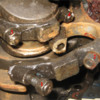The carnage in the picture below has been happening to 351C lower ends since day 1. Most "mechanics" interpret it as bolt failure because rod bolt #1 is snapped in two! This is why it has been common practice to replace the rod bolts for the last 4 decades.
However, observe there is less thread protruding beyond the end of the nuts of the busted rod (1 & 2) compared to the nuts of the good rod (3 & 4).
The threads in one or both nuts gave way, the bolts pulled out of the nuts, the loose cap hammered or sheared the bolt in half and a moment later this motor came to a stop. There is no evidence of a spun bearing, so it is safe to assume this happened very quickly and the nuts were the source of the failure.
Yes I still believe replacing the rod bolts with 180,000 psi ARP bolts is a good idea, the OEM bolts are only rated for 150,000 psi, so the ARP hardware makes the lower end 12% tougher ... but the simple fact is replacement of the nuts alone has proven to prevent a street motor from failing in this manner. It is an easy to perform, cost effective way to fix one of the Cleveland's weaknesses. Replacing the bolts requires re-sizing the big ends of the connecting rods, therefore the motor must come completely apart. Replacing the nuts alone can be done in an afternoon simply by dropping the oil pan.
-G
PANTERA INTERNATIONAL
A DE TOMASO CAR CLUB
Presents the De Tomaso Forums
The On-Line Meeting Place for De Tomaso Owners and Enthusiasts From Around the World
Clicking on the banner will take you to the sponsor's website.


